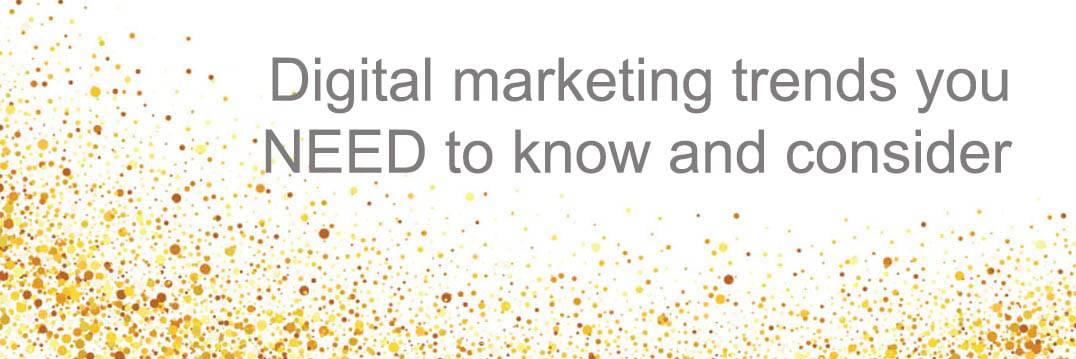Digital marketing trends you NEED to know and consider
Every year brings new digital marketing opportunities to drive demand and increase conversions for clients. After all that is what it is all about. Just like every sector, advances in marketing technology is paving the way for provocative, engaging digital experiences. Marketers need to capitalise on these trends to reap the ROI benefits and give their clients the ultimate competitive edge.
The main top digital marketing trends are unsurprisingly content marketing, big data and marketing process/automation.
Content marketing
Content needs to be educational, relevant and detailed. Content marketing is here to stay, over the last 3 years it has increasingly become more and more important but the rules are changing. Blogs are the bread and butter of content marketing. If you’re not going to do it properly don’t bother at all, as blog posts under 350 words are no longer good enough. Blogs under 500 words won’t be SEO friendly and might not provide readers with enough information. Blog posts ideally need to be around 1000 words and above but without waffle.
Businesses need to approach content marketing using a strategic approach. We will now see the art of copywriting coming back into play and marketing communications gravitating back to being an art and not just a gimmick… Let’s have some well-considered, substance!
People want long form content that is easy to digest. Readers want to be educated and inspired, having either finished reading the piece having learned new facts or be in a state of thought provocation. If you can provide an in-depth look at your chosen subject matter it will help you to build trust with your audience, demonstrate your authority and expertise, and increase the likelihood of social media shares and engagement.
Video content marketing is all the rage and that was just the beginning, this year video will increase both in organic and paid search. Video is taking content marketing by storm, but you’ll have to do more than just make one to realise its full potential. Most clients are nervous of video as it has the potential to be expensive and/or look a tad naff, I mean who wants to see company employees rambling on about how great their company is! but it doesn’t have to be this way. You have a short time frame to engage people on video so think short, snappy, and subtitled (since most video content is consumed with no audio) and include a really targeted call to action point. Advances in technology also mean video platforms like Vimeo, You Tube and Wistia have enabled detailed analytics for video content to help marketers measure the ROI. If you haven’t already experimented with video as a digital content marketing tool, make sure you find a way to weave it in your digital marketing strategy moving forward. If you want to chat through any ideas and ways to use video in your content marketing strategy just give us a call.
Also with the death of vine, keep your eyes open for Live Video Streaming which is anticipated to fully take off. Social media users are beginning to demand more in-the-moment content, giving them a vicarious view into a world (or event) they’d previously been unable to access. Thanks to faster Internet and the ubiquity of mobile devices, live video has become something of a trend on its own, with more and more apps and platforms giving some kind of “live streaming” functionality.
Big data and marketing process/automation
You should also be considering more focus on measuring content marketing ROI. Have you got reporting structures and processes in place? and more importantly, do you understand the data and how to evolve, automate and improve your output? As the demand for content increases, so will the associated costs and competition so data analysis is crucial.
Customer analytics (48%), operational analytics (21%), fraud and compliance (12%) new product & service innovation (10%) & enterprise data warehouse optimization (10%) are among the most popular big data use cases in sales and marketing. A recent study by DataMeer found customer analytics dominate big data use in marketing departments, supporting the four key strategies of increasing customer acquisition, reducing customer churn, increasing revenue per customer and improving existing products.
With data, marketers can exploit the value to increase sales through personalisation on websites and through email marketing through predictive analytics. Using predictive modelling gives your campaigns an edge over competitors.
Shockingly 36% of companies aren’t using anything more than basis marketing automation. This means if you can ensure you’re using effective, thought-through marketing automation you are already ahead of a 1/3rd of your competition. As businesses progress into digital marketing and embrace it and the benefits it can provide, you’d expect more to be putting lead scoring in place, or refining it and learning the best places on the journey to feature content through predictive analytics.
Interestingly though there can be limitations with data, if your data is rubbish you’re going to get rubbish results. Also it is all about your data size. For instance, people are becoming more and more aware of the limits of A/B testing. Understanding that you can’t effectively A/B test when there is not enough of a sample size. You might not have enough data to analyse and define customer characteristics and behaviour. Sometimes you just have to go with your intuition and common sense! Small to medium sized businesses don’t always have big data at their disposal, and that means marketers need to be comfortable executing in ambiguity.
I hope this piece has either educated you or started your thoughts racing as to how you will include them (along with researching even more digital marketing trends) into your marketing plans. If you would like some help solidifying your plans get in touch… in fact why not have a video call.


Leave a Reply
You must be logged in to post a comment.